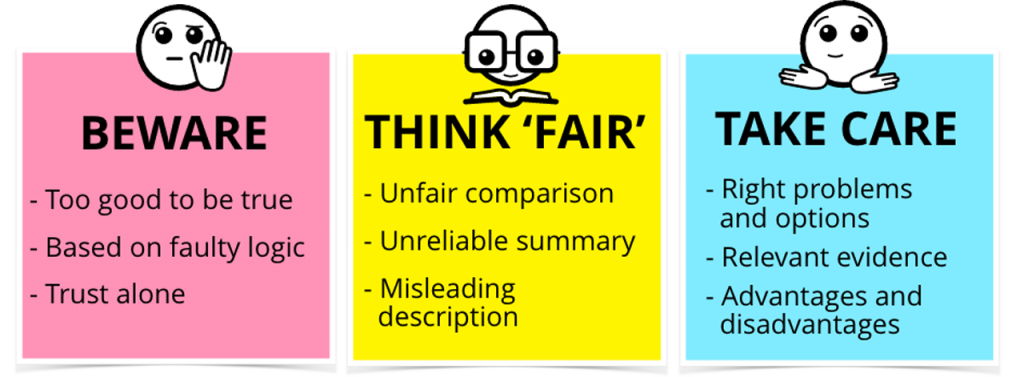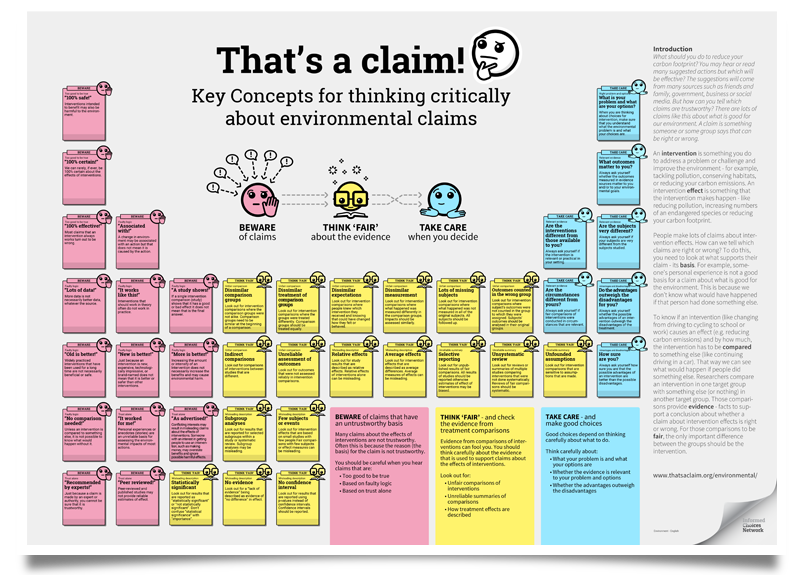Introduction
What should you do to lessen our impact on the environment? There are lots of claims about what you should and should not do. How can you know which of these claims are trustworthy? And how should you decide when to act on claims about what is good or bad for the environment?
An “intervention” can be anything you choose to do to benefit the environment, locally or globally — for example, using less plastic, reducing waste or energy use, managing habitats for wildlife. It can also be something that we do for the health of a community — for example, making sure that water is safe to drink, or reducing the use of fossil fuels. An effect is something a chosen intervention makes happen—like conserving native species, reducing pollution, or improving river water quality.
A claim is something someone says that could be right, but could be wrong. People make lots of claims about intervention effects. How can we tell which claims are right or wrong? To do this, you need to look at what supports their claim – its basis. For example, someone’s personal experience is not a good basis for a claim about what is good for the environment. This is because we don’t know what would have happened if that person had done or observed something else.
To know if an intervention causes an effect (like reducing pollution) the treatment has to be compared to something else (like no intervention). Researchers compare an intervention given to one group with something else given to another group. Those comparisons provide evidence – facts to support a conclusion about whether a claim is right or wrong. For those comparisons to be fair, the only important difference between the groups should be the treatment they receive.
A good choice is one that uses the best information available at the time. For environmental choices, this includes using the best available evidence of intervention effects. Good choices don’t guarantee good outcomes, but they make good outcomes more likely.

Three groups of guides
Many claims about the effects of interventions are not trustworthy. Often this is because the basis for the claim is not trustworthy. The first (pink) group of guides are things you should watch out for when you hear or read a claim about environmental impacts (positive or negative).
It is always a good idea to question what evidence there is to support a claim. Evidence about the effects of interventions comes from intervention comparisons. The second (yellow) group of guides can help you decide how trustworthy that evidence is.
Knowing how trustworthy the evidence is can help you make good choices. But there are other things you need to think about when you decide what to do and what not to do for the environment. The third (blue) group of guides can help you make good choices.
Using the guides
There are endless claims about our lifestyle choices and impacts on the environment in the mass media, advertisements, and everyday personal communication. This includes claims about the effects of what we choose to wear, the transport we use; claims about lifestyle changes, such as changes to what you eat or how you exercise; claims about the organisations you might support; claims about pro-environment actions; and claims about changes in how environmental management is financed and governed.
Some of these claims are true and some are false. Many are not supported by trustworthy evidence: we do not know whether they are true or false. Claims about the effects of interventions that are not supported by trustworthy evidence often turn out to be wrong. Consequently, people who believe and act on these claims may waste resources by doing things that do not help and might be harmful, and by not doing things that do help.
The Collaboration for Environmental Evidence developed the Informed Environmental Choices Key Concepts with the aim of helping people make better informed choices. This website includes all of the Key Concepts (guides). The Key Concepts are the starting point for developing learning resources, such as this website.
The website and the poster can be used in different ways. For example, by finding examples of claims in the media and – using the guides – thinking critically and discussing how trustworthy those claims are and what you would do. For each guide, we have provided links to examples and some additional learning resources.
Please contact us and share your experience using this website and any suggestions you have.
